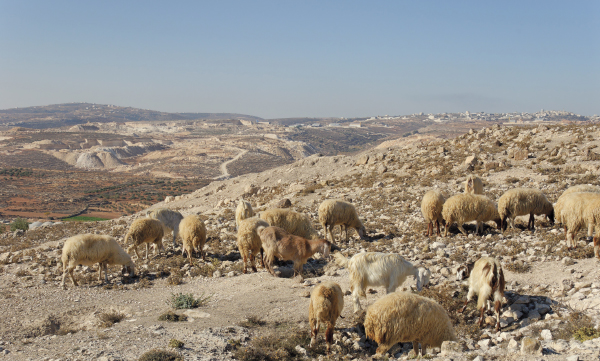Amos
by Philip S. Johnston

Sheep and goats grazing at Tekoa
Todd Bolen/www.BiblePlaces.com
Introduction
For the immediate historical background, see the introduction to Hosea.
Introduction (1:1–2)
Amos (1:1). Most Old Testament characters are introduced with their patronymic (“son of …”) or at least qualified by a place name (“Micah of Moresheth,” Mic. 1:1). Amos is distinctive in having no further identification, but this is not unique.1 He is definitely not Isaiah’s father (Isa. 1:1)–their names differ even more in Hebrew than in English. His name was not uncommon in the ancient Levant; it appears on two seals from the same general area and period, and in Phoenician and Punic sources.2 It has a passive form and means simply “protected.”

Seal with inscription, “Amos the scribe”
Z. Radovan/www.BibleLandPictures.com
One of the shepherds (1:1). Amos was a farmer by trade, not a professional or permanent prophet, as he later protests fiercely (7:14). However, the word translated “shepherds” (nōqedîm, pl. of nōqēd) is not the usual one for someone who keeps sheep (rō ʾeh). It only occurs elsewhere in the Old Testament in 2 Kings 3:4 of King Mesha of Moab, who paid Israel an enormous tribute, and it means more a “sheep-breeder.” The same Semitic term occurs in Akkadian (nâqiddu) and Ugaritic (nqdm).3 Amos later employs the different term “herdsman” (bôqēr, 7:14),4 which normally refers to cattle-herding. So he probably kept a range of animals, though both terms may be fairly general.
Amos also describes himself as a “dresser of sycamore trees” (7:14). This involves scraping or piercing the figs to hasten their growth and repel insects. However, sycamores grew only in the western foothills and the Jordan Valley, so Amos was either a migrant worker to the former or more probably owned sycamore groves in the latter. Either way, he was an ordinary farmer used to hard manual labor.
Tekoa (1:1). This town was situated about five miles south of Bethlehem and ten miles south of Jerusalem, on the eastern fringe of the cultivated central hills and with the “Desert of Tekoa” (2 Chron. 20:20) to the east, leading down to the rift valley.
The earthquake (1:1). Israel’s territory lay along the geological fault line running from Asia Minor to Africa’s Great Rift Valley, so was prone to earthquakes. This one is not mentioned in contemporary texts (except perhaps Isa. 5:25), but must have been extremely strong, since it was cited centuries later to illustrate the upheaval of God’s future appearing (Zech. 14:5).
This earthquake is now “established in the archaeological record,”5 with evidence from Hazor, Gezer, Beersheba, and possibly Lachish, Deir ʿAlla, Ashdod, and Bethel. Later Josephus (Ant. 15.5.2) records an earthquake in 31 B.C. that killed 10,000 people. Other earthquakes in 64 B.C. and A.D. 34 are known to have damaged the Jerusalem temple. Since then, “in the past two millennia Palestine has had seventeen recorded earthquakes of major proportions,”6 at least one of which left thousands dead.
Earthquakes became a common prophetic motif of future calamity and one is implied in Amos 9:1, which uses the same Hebrew root (rʿš) for “shake.” More importantly for Amos, this one must have validated his ministry as a true prophet of Yahweh.7
Uzziah … Jeroboam (1:1). Uzziah of Judah (also called Azariah, 2 Kings 15:1) became coregent in 791 B.C. and reigned from 767 to 740.8 He is mentioned first because Amos was a southerner and/or this dating was more helpful to later Judean readers. Jeroboam II (so-called to distinguish him from northern Israel’s first king, Jeroboam I, 1 Kings 12:20) became coregent in 791 and reigned 782 to 753. These men reigned during the half-century of political expansion and economic prosperity for both kingdoms.

The Lord roars (1:2). Normally it is lions that roar (as in 3:4, 8). Here, the first divine comment on this complacent society was not a reasoned argument but a blood-curdling leonine “roar,” which withers all vegetation from lowland pasture to Mount Carmel’s peak. If this is literal, it suggests a devastating drought–often a mark of divine punishment, as it was for Ahab earlier (1 Kings 17:1). If it is metaphoric, as perhaps more likely, it is a chilling image of divine judgment (cf. Jer. 25:30; Joel 3:16). Similarly a Sumerian hymn to the goddess Inanna acclaims: “When you roar at the earth like Thunder, no vegetation can stand up to you.”9
From Zion (1:2). The unambiguous proclamation of God’s “home” in Zion/Jerusalem might immediately alienate a northern audience. Yet Amos does not criticize Israel as schismatic, separated from the Jerusalem temple and the Davidic monarchy. He pronounces God’s judgment for fundamental issues of injustice and oppression.